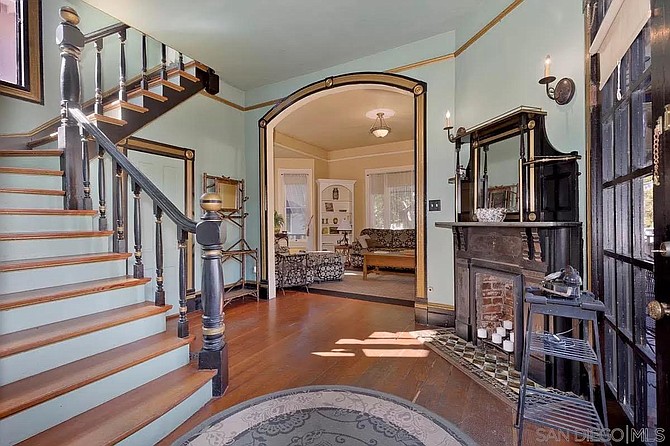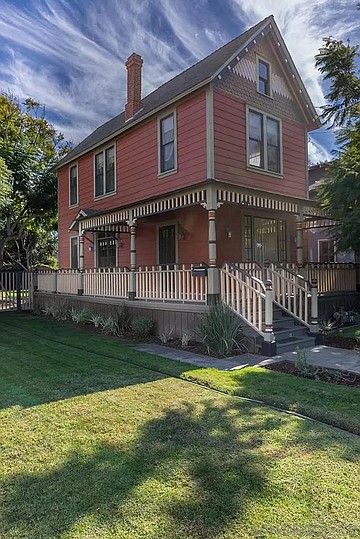 Facebook
Facebook
 X
X
 Instagram
Instagram
 TikTok
TikTok
 Youtube
Youtube

We’re all familiar with the Hotel del Coronado, right? The iconic landmark, opened in 1888, has long been the preferred San Diego home base for presidents, royalty, celebrities, and other well-heeled travelers. It’s among the last of the Victorian-style beach hotels that used to dot the coast — most of them hastily erected by developers eager to lure land buyers to otherwise desolate locales.
The Hotel Del did inspire some construction on the peninsula, but it was completed right around the time the real estate market in San Diego began a decade-long tumble, so it ended up taking longer than investors would’ve liked to sell off lots in their new town. One of the survivors of that era, however, is currently up for sale, and billed in Zillow’s listing remarks as the “quintessential Victorian beach house, an historic landmark known to locals as the ‘red Victorian.’” The home at 1021 E Avenue was built around 1890 and “stands as an icon of timeless elegance and architectural pedigree,” with the listing claiming it’s “the oldest surviving Queen Anne Victorian on the island,” behind only the Del itself. Shall we take a look?
We start our tour outside, looking at a house that is indeed quite red. I like the wraparound veranda and the detailed columns supporting the roof — craftsman touches often missing from the modern McMansions we spend a lot of time with here at Unreal. The vintage tone gets carried into the entry foyer, with its fir floors, gold-accented archway and stair balusters, and the massive brick fireplace (relegated to modern duty as an oversized candle station). The teal paint on the walls and staircase risers adds a nice pop of color that’s similarly lacking in newer builds. There’s a powder room tucked under the stairs and a magenta sitting area off to one side, and we’re told the double-hung wooden windows in the home hail from the original construction. That gives some weight to the claim that “every aspect reflects a bygone era of craftsmanship.” We move along into a small blue dining room, and even though it’s a touch on the dark side, I still like the boldness of putting actual color on the walls, especially a different color in every room.

The kitchen is a little odd. It looks like it was updated maybe 40 or 50 years ago, and while it’s in good shape, I can’t say I’m a fan of the laminate countertops or the cheap-looking cabinetry. There’s not even room for a full-sized refrigerator, and the low ceilings — especially over the stove — make me feel a bit claustrophobic. I’m guessing these design flaws reflect an era in which the owner of a house like this would have hired a servant to do most of the cooking, which often meant treating the actual facilities for doing so as an afterthought, design-wise. I would have to change this if I lived here, but I’m not really sure how I’d manage it.
Moving on, we see another living room — this one much brighter, with cream-colored walls and lots of windows — before moving upstairs to peek inside a small bedroom and a very pink bathroom with a claw-foot tub, pedestal sink, and separate shower. Another seafoam bedroom has a cozy window nook, and I’m starting to notice the intricate original doorknobs as I hunt for a close-up of how, as the listing puts it, the “etched hinges showcase artistry rarely seen today.”
Finally, we get to see an unfinished attic that, despite the steep pitch of the roof, still looks spacious and very much deserving of conversion into living space. I just don’t know how we’re going to get any furniture up through the tiny ladder hole.
Back outside, we finish our tour with a few photos of the backyard, which has enough room for an outdoor dining area and a patch of grass surrounded by old-growth trees that lend privacy. It’s not huge, but it’s big enough that I think I could just manage to maintain it without hiring a gardener. A few aerial shots round out the listing, highlighting the location: just a block from the beach on the peninsula’s ocean side.
Public records list a Wohl and Hatcher family as the property’s current owners. This is the first time it’s been offered for sale in 26 years. The listing notes that the home recently received Mills Act approval, which means the new buyer will be able to take advantage of a property tax break in exchange for preserving the historical character. “A once-in-a-generation chance to acquire a home steeped in history and charm, this is more than a place to live,” the listing concludes. “It is a testament to Coronado’s heritage and an invitation to be part of its legacy.”
The E Avenue residence was listed for sale in mid-November; its asking price of $3,625,000 remains unchanged to date. If you’ve got that kind of money and get the appeal of this home, please let me know what you do with the kitchen and attic, but also please leave everything else alone.
1021 E Avenue | CORONADO, 92118
Current owner: Wohl/Hatcher | Listing price: $3,625,000 | Beds: 3 | Baths: 2 | House size: 1288 sq ft


We’re all familiar with the Hotel del Coronado, right? The iconic landmark, opened in 1888, has long been the preferred San Diego home base for presidents, royalty, celebrities, and other well-heeled travelers. It’s among the last of the Victorian-style beach hotels that used to dot the coast — most of them hastily erected by developers eager to lure land buyers to otherwise desolate locales.
The Hotel Del did inspire some construction on the peninsula, but it was completed right around the time the real estate market in San Diego began a decade-long tumble, so it ended up taking longer than investors would’ve liked to sell off lots in their new town. One of the survivors of that era, however, is currently up for sale, and billed in Zillow’s listing remarks as the “quintessential Victorian beach house, an historic landmark known to locals as the ‘red Victorian.’” The home at 1021 E Avenue was built around 1890 and “stands as an icon of timeless elegance and architectural pedigree,” with the listing claiming it’s “the oldest surviving Queen Anne Victorian on the island,” behind only the Del itself. Shall we take a look?
We start our tour outside, looking at a house that is indeed quite red. I like the wraparound veranda and the detailed columns supporting the roof — craftsman touches often missing from the modern McMansions we spend a lot of time with here at Unreal. The vintage tone gets carried into the entry foyer, with its fir floors, gold-accented archway and stair balusters, and the massive brick fireplace (relegated to modern duty as an oversized candle station). The teal paint on the walls and staircase risers adds a nice pop of color that’s similarly lacking in newer builds. There’s a powder room tucked under the stairs and a magenta sitting area off to one side, and we’re told the double-hung wooden windows in the home hail from the original construction. That gives some weight to the claim that “every aspect reflects a bygone era of craftsmanship.” We move along into a small blue dining room, and even though it’s a touch on the dark side, I still like the boldness of putting actual color on the walls, especially a different color in every room.

The kitchen is a little odd. It looks like it was updated maybe 40 or 50 years ago, and while it’s in good shape, I can’t say I’m a fan of the laminate countertops or the cheap-looking cabinetry. There’s not even room for a full-sized refrigerator, and the low ceilings — especially over the stove — make me feel a bit claustrophobic. I’m guessing these design flaws reflect an era in which the owner of a house like this would have hired a servant to do most of the cooking, which often meant treating the actual facilities for doing so as an afterthought, design-wise. I would have to change this if I lived here, but I’m not really sure how I’d manage it.
Moving on, we see another living room — this one much brighter, with cream-colored walls and lots of windows — before moving upstairs to peek inside a small bedroom and a very pink bathroom with a claw-foot tub, pedestal sink, and separate shower. Another seafoam bedroom has a cozy window nook, and I’m starting to notice the intricate original doorknobs as I hunt for a close-up of how, as the listing puts it, the “etched hinges showcase artistry rarely seen today.”
Finally, we get to see an unfinished attic that, despite the steep pitch of the roof, still looks spacious and very much deserving of conversion into living space. I just don’t know how we’re going to get any furniture up through the tiny ladder hole.
Back outside, we finish our tour with a few photos of the backyard, which has enough room for an outdoor dining area and a patch of grass surrounded by old-growth trees that lend privacy. It’s not huge, but it’s big enough that I think I could just manage to maintain it without hiring a gardener. A few aerial shots round out the listing, highlighting the location: just a block from the beach on the peninsula’s ocean side.
Public records list a Wohl and Hatcher family as the property’s current owners. This is the first time it’s been offered for sale in 26 years. The listing notes that the home recently received Mills Act approval, which means the new buyer will be able to take advantage of a property tax break in exchange for preserving the historical character. “A once-in-a-generation chance to acquire a home steeped in history and charm, this is more than a place to live,” the listing concludes. “It is a testament to Coronado’s heritage and an invitation to be part of its legacy.”
The E Avenue residence was listed for sale in mid-November; its asking price of $3,625,000 remains unchanged to date. If you’ve got that kind of money and get the appeal of this home, please let me know what you do with the kitchen and attic, but also please leave everything else alone.
1021 E Avenue | CORONADO, 92118
Current owner: Wohl/Hatcher | Listing price: $3,625,000 | Beds: 3 | Baths: 2 | House size: 1288 sq ft
Comments